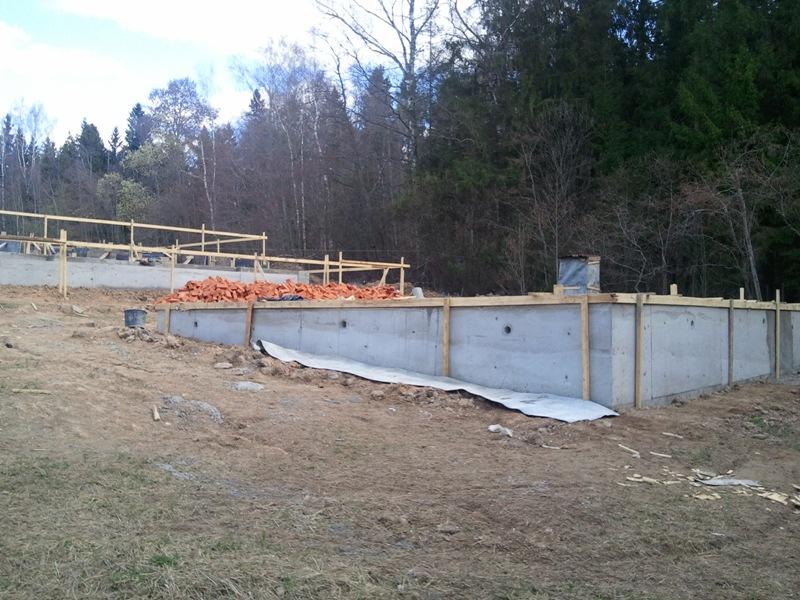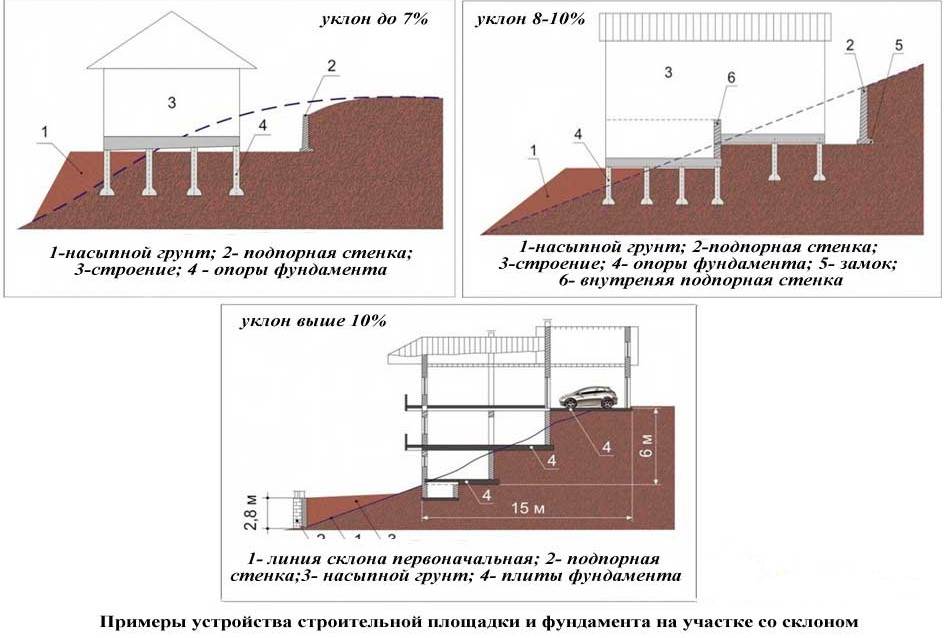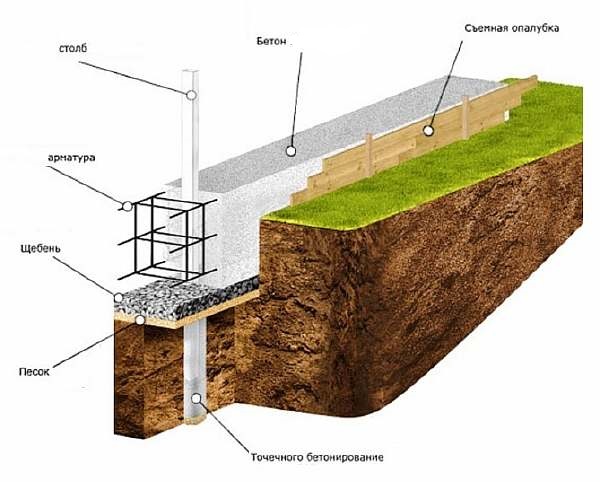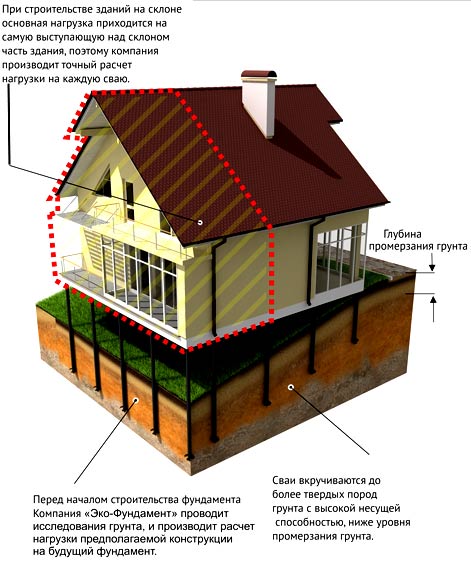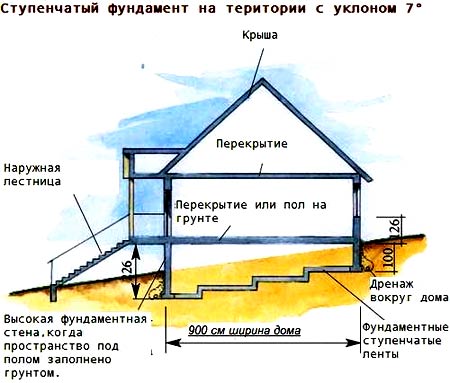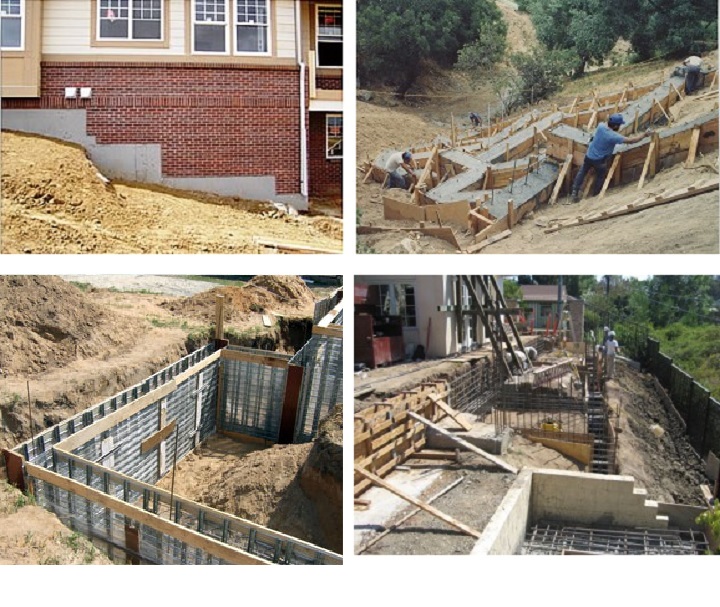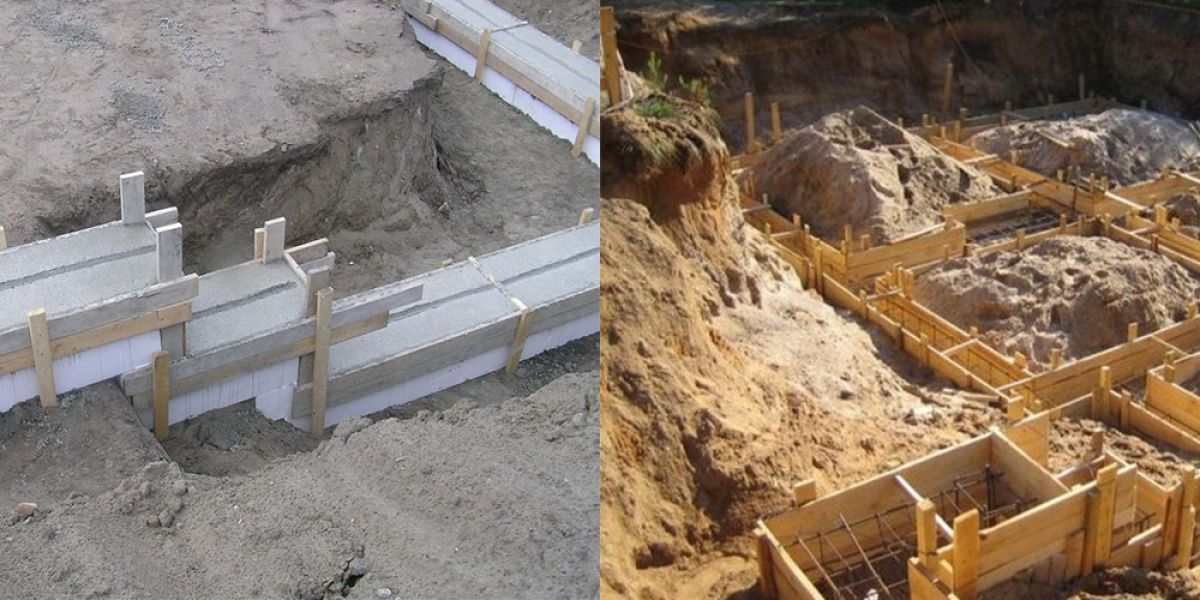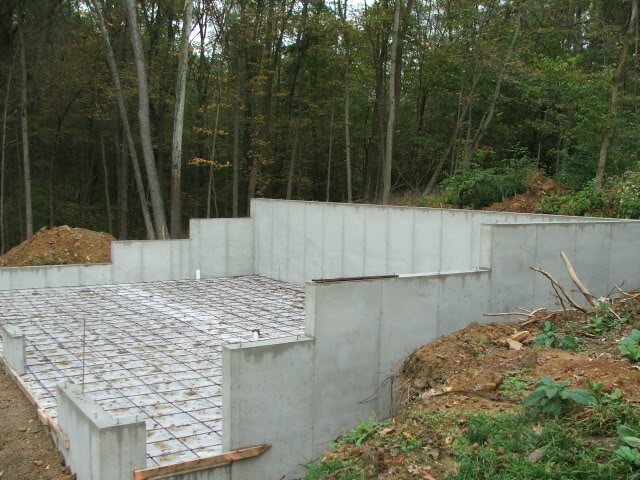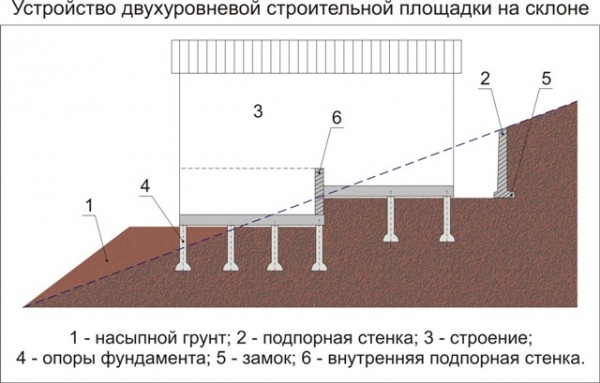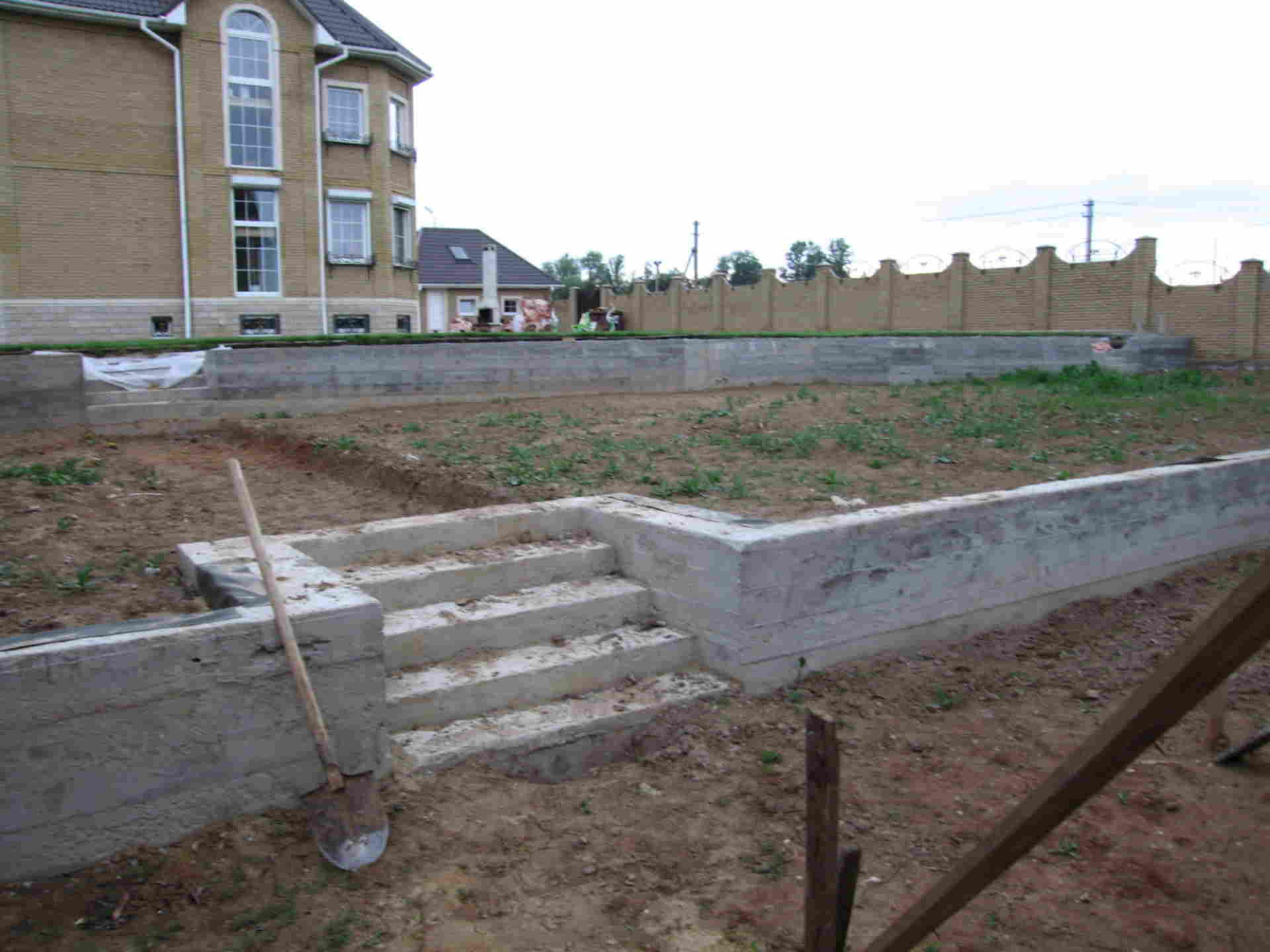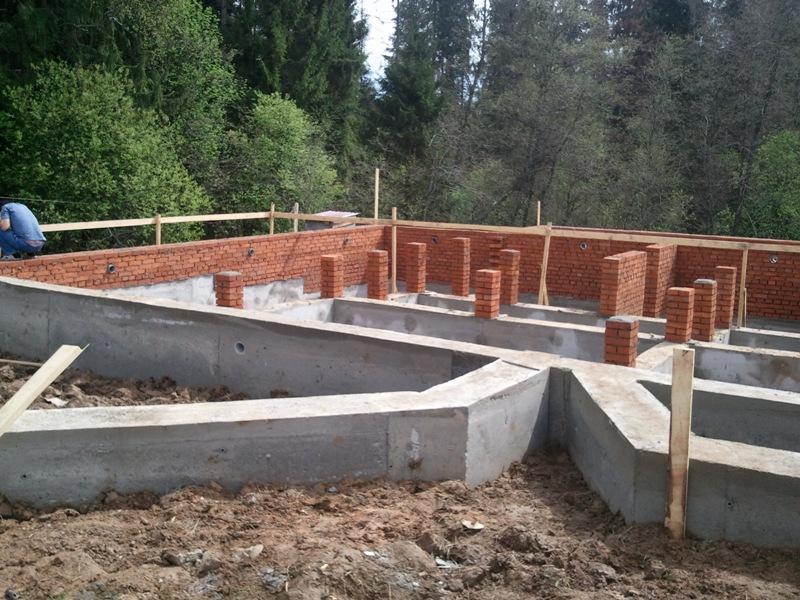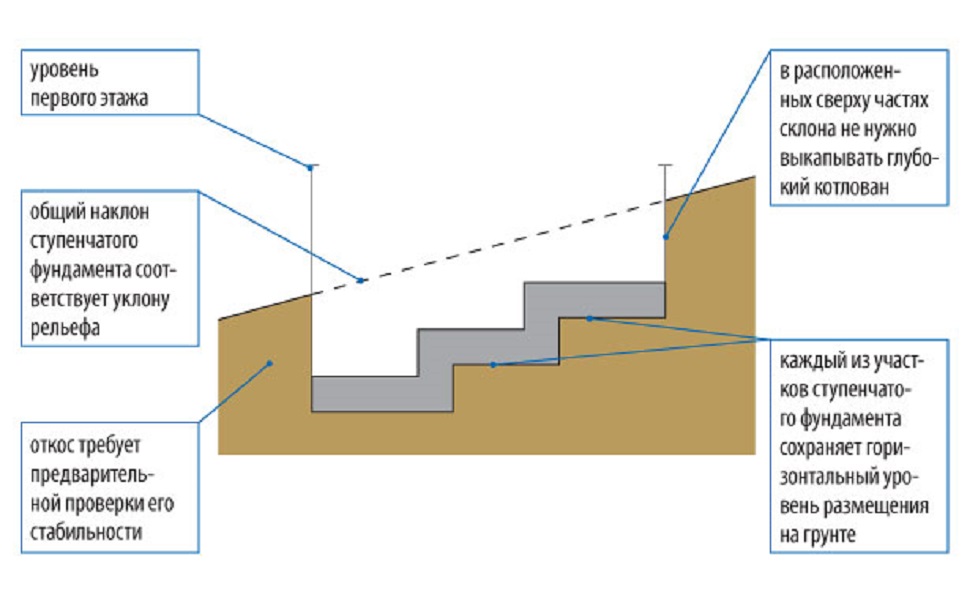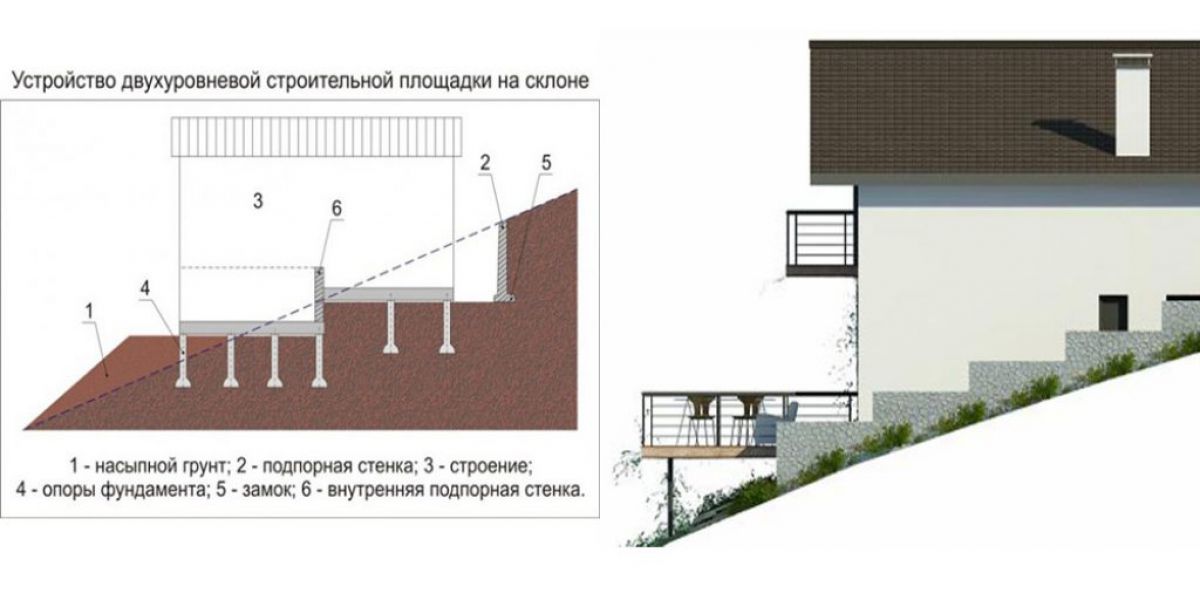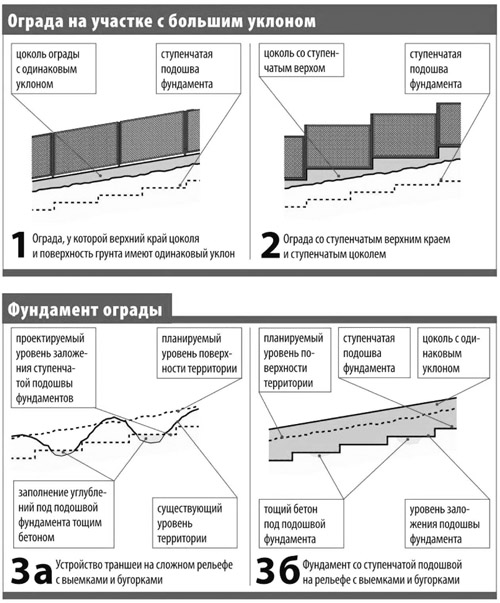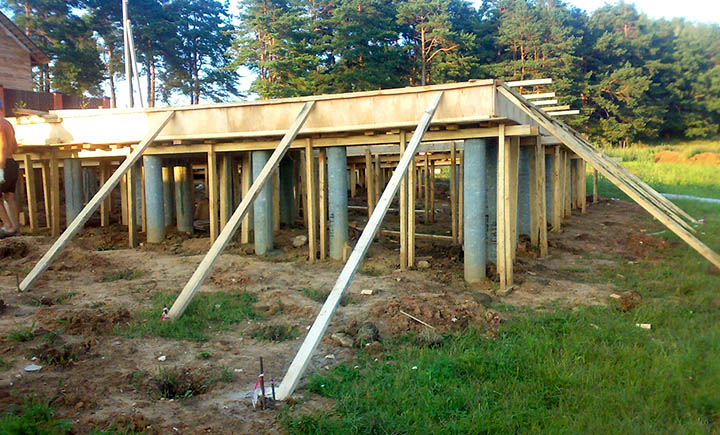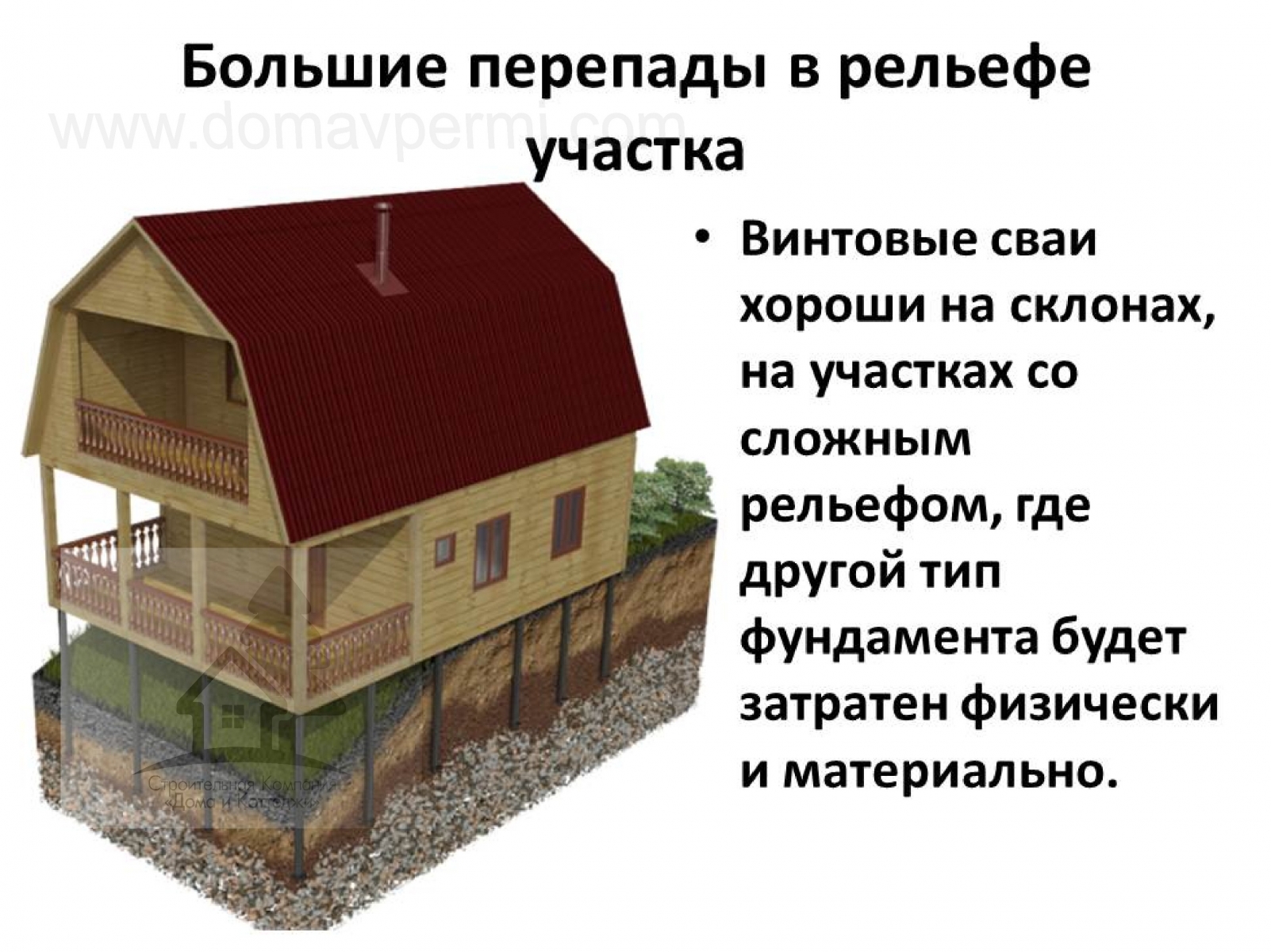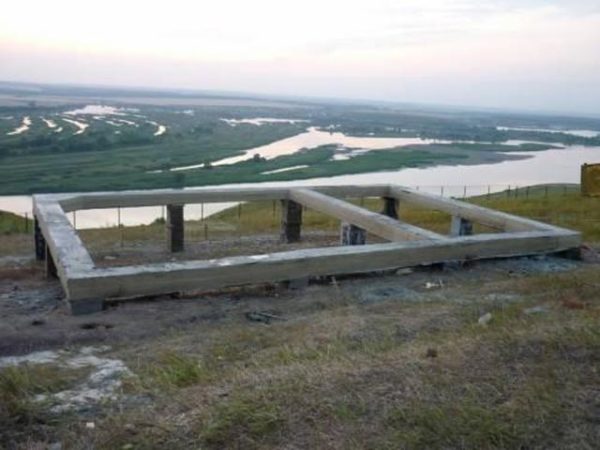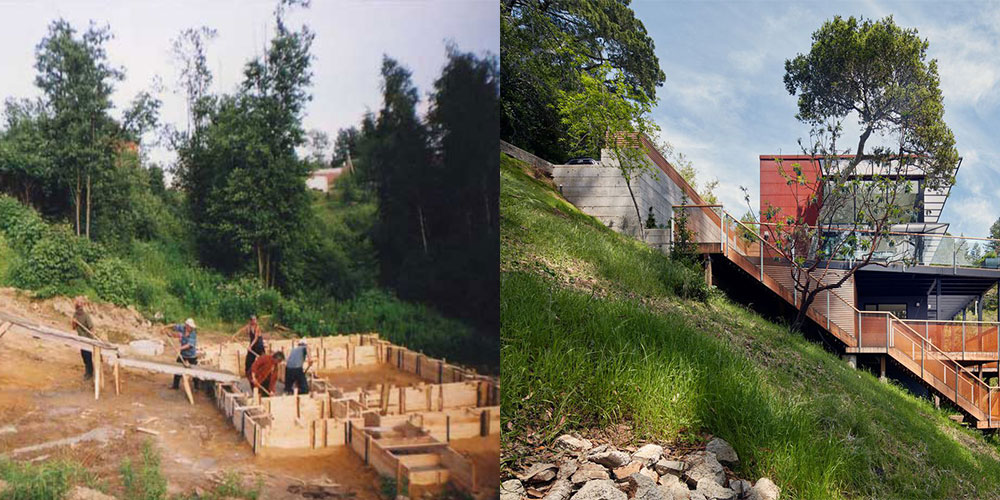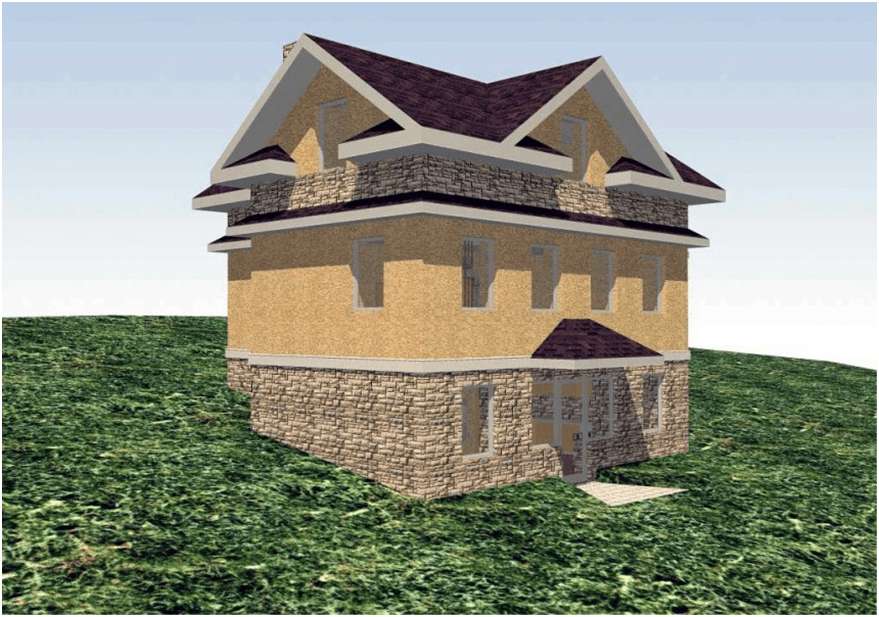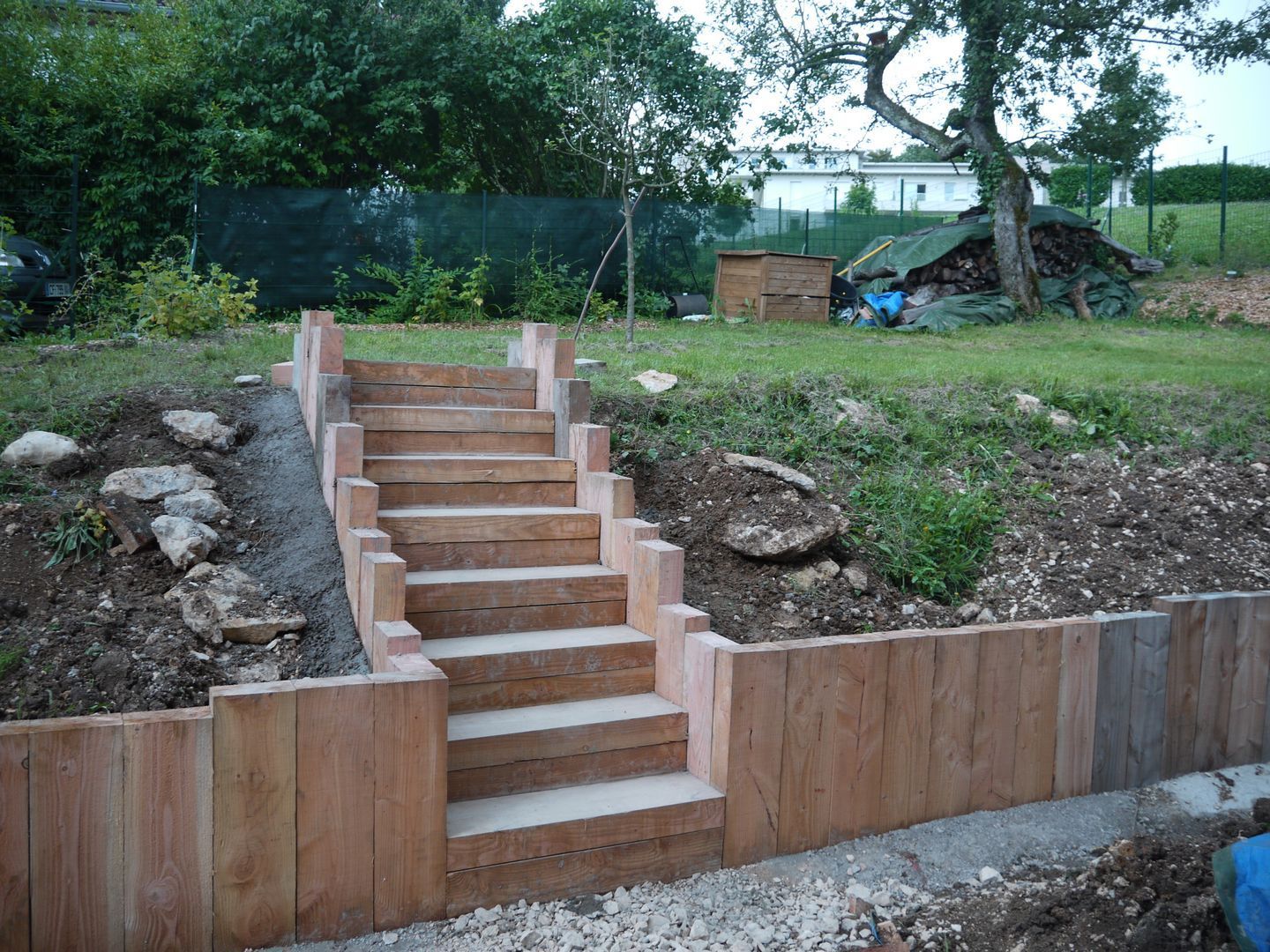Erection of foundations on medium slopes
 Columnar base for uneven areas
Columnar base for uneven areas
Here it is already worth thinking about which type of foundation is better to use. For example, for a strip base, you will have to use a lot of bedding, and this must be done first at the lowest point and then evenly level the bottom horizontally. Such construction will be financially costly, but it can be used in the construction of small buildings.
Alternatively, you can use a columnar-strip foundation here. It has a number of advantages over conventional tape, namely:
- no need to carry out detailed geodetic calculations and select the optimal installation depth of the tape;
- here a minimum of a sand cushion is used, and the pillars can even be installed in several tiers;
- directly on the ready-made poles, you can install a concrete tape.
It is clear that such a foundation on an average slope costs a little more, but in some cases it justifies itself. The construction of a tape structure has a number of nuances, namely:
- Incorrectly placed and tamped bedding will creep over time, and then the tape.
- Before creating a sand cushion, you must first equip a pit with smooth walls, and only then lay the pillow.
- It is not necessary to strictly adhere to the same thickness of the pillow, it can be different, but not less than 30 cm.
After the construction of the structure, you need to make a vertical dumping of soil. For this, non-porous soil is used, for example, sand. The blind area must be made to the side of the base at a slight angle, but always with a slope upward.
Building a house on the relief
Terrain relief means the structure of the surface - mountains, lowlands, hills, valleys, ravines, bulges and depressions, plateaus. The relief is determined by the slope - the fall of the surface, which is calculated by the ratio of the difference in height between two points on the terrain to the distance between these points, projected onto the horizontal (see figure) or the tangent of the slope of the terrain line to the horizontal plane at a given point. The slope is measured as a percentage. For example, a rise of 15 m per 100 m of horizontal movement corresponds to a slope of 0.15 (15%).
Terrain slope scheme
A flat terrain is considered if its slope is no more than 3%, a small slope of the terrain is from 3 to 8%, an average slope is up to 20%, a steep surface has more than 20% slope. The best from the point of view of construction are areas that are flat or with a minimum (up to 3%) slope towards the south, as well as those that have a minimum slope from the central part down on both sides (Fig.)
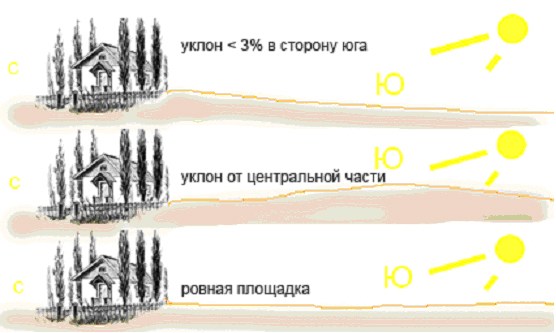
Schemes of the most successful construction sites with a minimum slope
Here, construction is as easy as possible: with such a relief on the site, you can implement various options for the location of the house and other buildings.
Sites with a slope of up to 3% can be used in the construction of typical houses. Only small slopes are required to drain water from buildings - they are created by adding soil, when with the help of stones, gravel, cement, a slight slope is created from the house to the surface with a height of approximately 50 cm.The width of the filling is on average 1-1.5 m wider than foundation.
If the slope is small - up to 7%, then it is suitable for the construction of buildings without basements. True, it is possible that at a 5-7% slope it will be necessary to add soil from the submontane part (see Fig.).

Site with a low slope of 5-7% with soil filling into the foothill part of the slope
If the slope has exceeded 8%, the unevenness of the surface can be used for the construction of the basement. In such cases, they do not make a flat area, but create a lower floor by cutting out a part of the slope massif. This option is good for the construction of an underground garage, if access is possible from the side of the slope (see fig.).

Site with a cut out part of the slope for the construction of an underground part (garage, etc.) with a slope above 8%
When the slope is steep and exceeds 15-20%, it is worth thinking about developing a special house project that uses all the possibilities of a steep slope. The inconveniences of the slope can be turned into indisputable advantages if you use it for the construction of a multi-tiered dwelling, which will make it possible to create separate blocks in the building: for example, guest rooms with their own entrance, a workshop, a summer kitchen, a garage, a storage room. If you have to build on difficult terrain, you need to turn the site into several leveled, flat surfaces. All buildings are placed on horizontal platforms, and their width determines the size of the buildings.
For this, terraces are created, which are fixed by retaining walls, and connected by steps. Already at a 12% slope, it is best to erect buildings on terraces (see Fig.).

A site with a steep slope (more than 15%) equipped with terraces with retaining walls
A house built on terraces can be multi-level, have verandas on different levels, balconies, patios. Terraces also have playgrounds, paths, recreation areas, gazebos, and so on.
In the case of a significant difference in relief, more than 15%, it is recommended to install the retaining walls so that the vertical seams in adjacent rows of stones do not coincide. Retaining walls are made of concrete slabs, boulders, bricks, beams, stones (see Fig.).

Terrace made with retaining walls made of boulders with a slope of more than 15%
At a high wall height, the stones are fastened with a solution. The largest stones are located in the bottom row. To increase the strength of the retaining wall, all rows of stones are laid with an inward slope. The slope along the boundaries of the site is also fixed with stones, and the best material for this will be granite, sandstone, limestone.
What to choose
We've looked at several options that you can use for steep terrain. They all have their pros and cons. Let's immediately determine that the slab foundation is not suitable. You can make a hit parade by analyzing all the pros and cons of each foundation. So, in the last place is the slab base. Well, they rarely choose it. What should you put in third place? Of course, a strip foundation, in view of the fact that its construction will require a lot of effort, land work and investment.
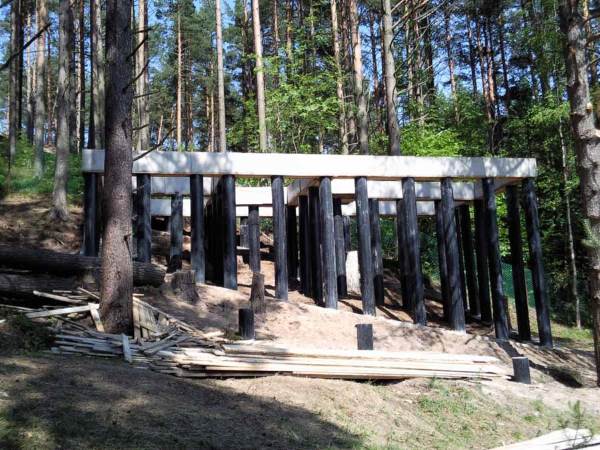
The columnar foundation broke into second place. It is good, but not as good as our winner, namely the pile foundation. Only he deserves the highest praise when it comes to problematic soil with a slope. It's all about the ease of installation, the minimum amount of work and investment.
DIY wire fence
The design of a barbed wire fence begins with the choice of the type of structure, the installation of the product itself will depend on this. Next, you need to determine whether it will be an independent structure or additional to an already finished structure.

For an independent fencing, it is necessary to have support pillars, between which the wire will be attached. Racks are chosen from wood, metal or concrete. Installation takes place by implanting racks into the ground at a certain distance. The gap between the posts should not exceed 2.5-3 meters.

If you are going to design a fence yourself, you need a list of special tools, as well as protective gloves, tight clothing to protect yourself from injury.


Installation algorithm:
- Territory marking
- Installation of support legs
- Installing brackets by bolting or welding
- Installation of the barbed spiral on top of the brackets using special brackets
- Pulling a double string through the entire length of the spiral
- Aligning the spiral and its fasteners using special twists
- Installation of barbed wire between posts at a distance of 15-20 cm
- Connecting the wire to each other with mounting brackets.

To strengthen the structure, the wire is connected to an electric current source. But for this you need to hang up a warning sign.
Barbed wire fencing is perhaps the best way to protect private property. The design does not require high costs and does not cause great difficulties in installation and operation. An excellent solution to protect your property from unwanted encroachments.

Construction of a strip base on a slope
The base in the form of a concrete tape is very popular with private developers, due to the ease of construction and low costs. However, the construction of a strip base on an area with a slope should be approached with special responsibility.
Like any construction process, the construction of the foundation takes place in several stages.
Site planning
At the first stage, it is necessary to draw up a detailed plan of the site for construction, located on the slope of any hill, and indicate the location of the future foundation. The main task is to determine the lowest point of the soil, since it will determine the depth of the strip base. Down from this point, measure the estimated height of the foundation and add about half a meter to a pillow of sand and crushed stone. When planning, it should be borne in mind that along the entire length of the base tape should lie at the same level, and its upper part rose slightly above the ground level.
Ways to reduce the slope of the site
In most cases, a section on a slope requires some reduction in the height difference, while the degree of complexity of the work depends on the magnitude of the slope.
An insignificant slope, not exceeding 3%, does not require complex work, for this it is enough to add soil in the right places and strengthen it with silicates.
Slopes up to 8% can be leveled by filling the strip base with soil that rises from the foothill part.
Differences up to 10% are considered problematic, but in this case, you can build a basement floor by placing it directly on the slope.
If the steepness of the slope exceeds 10%, then the construction of structures for protection against landslides is required on such a site.
Excavation
Digging a trench is one of the main stages of building a foundation on a slope, but this is where the whole process begins. At this stage, it is necessary to accurately follow the calculations performed, especially with regard to the depth of the foundation. This is due to the fact that this parameter will be different at different intervals.
Formwork construction
The presence of height differences on the site somewhat complicates the construction of the formwork, since, regardless of the degree of slope, the upper part of the base must be strictly horizontal. For this reason, the formwork at the lowest point of the slope will be significantly higher than at the highest point. It is also important to choose the right formwork board.
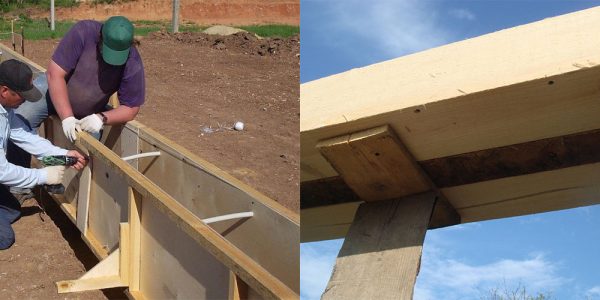
We make the formwork
At the bottom of the prepared trench, they must make a pillow of sand and crushed stone, and each layer is well tamped. The height of the pillow should be about 0.2 meters.
Reinforcement of the foundation
A tape base on a slope requires a reinforced reinforcing belt, for the manufacture of which steel rods are used. Neglect of this stage becomes the cause of deformation of the foundation and, as a result, the destruction of the entire structure.
Drainage system creation
To ensure effective drainage of moisture from the foundation and home, an excellent drainage system is needed.However, it is not recommended to perform this stage on your own, since special studies are required. Therefore, the creation of a drainage system should be performed by an experienced specialist.
Pouring concrete
The foundation on a slope must be poured in one step in order to prevent delamination of the concrete mass during the drying process, which can lead to a rapid destruction of the base.
The poured concrete solution is carefully compacted using a special device, which allows air bubbles to be removed. The finished foundation is left for about a month with proper care, so that the solution is completely dry and hardened.
Strip stepped foundation
Before starting work, you need to make a choice between different construction technologies:
- monolithic reinforced concrete;
- precast concrete.
For the same reason as in the previous version, the monolithic method of building a strip foundation is the most optimal. In addition, the foundation erected using this technology is a one-piece product. When erecting this type of foundations, the joint venture "Design and construction of foundations and foundations of buildings and structures" is guided.
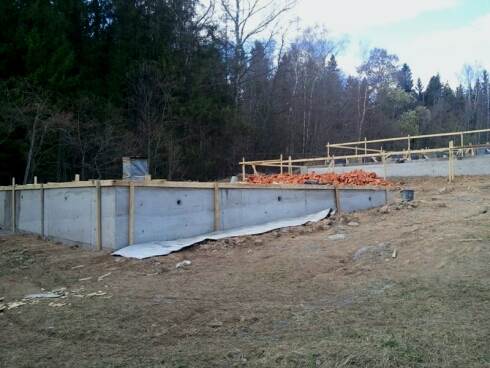
You can make a support under the house with a slope of 10% in the following order:
- The slope on which the tape will rest is cut in such a way that a stepped descent is formed. The calculation of the height and width of the ledges is performed so that the angle between the horizon line and the visual line drawn from the surface of the ledge to the base of the slope does not exceed 30 degrees.
- The steps of a kind of terrace are tamped and reinforced with a reinforcing mesh.
- A layer of soil is poured over the mesh.
- Trenches are dug under the retaining walls located across the slope, formwork is installed, and the foundation is poured. Walls along the slope are placed so that their edge is at the same level, while the height of the sole may differ.
- After the concrete has hardened, soil is added in order to level the difference between the lower and upper slope marks.
If the percentage of slope of the site is less than 8%, there is no need to make a stepped slope. The strip foundation is mounted as for a flat area
It is important to note that tape is one of the most disadvantageous types when working with elevation differences. Building at different levels will be very time consuming and costly
It should only be used when a basement device is needed.
Factors to consider when pouring
When constructing foundations on uneven areas with a slope of the surface, it is imperative to be guided by building codes and observe technology. But the more correct solution would be to attract professionals. The construction of such foundations has some distinctive features, mainly related to the implementation of preparatory measures and additional work.
The following important factors that you should pay special attention to will help get rid of unpredictable consequences in the future. 1
A competent foundation design is a prerequisite for the construction of an object on uneven sites. It includes the calculation:
1. A competent foundation design is a prerequisite for the construction of an object on uneven sites. It includes the calculation:
- dimensions of the base;
- weight load of the building on the foundation;
- the specific pressure exerted on the ground at various points;
- temporary loads.
The hydrogeological assessment of the site allotted for the construction and soil analysis are of great importance. For this, in most cases, they resort to drilling exploratory wells.
2. Creation of an efficient drainage system requires careful preliminary calculation. The accumulating moisture is the main source of many troubles that can lead to slipping and even collapse of the soil in the upland part.
3.Mechanical soil consolidation is an important addition to the drainage system when the terrain slopes are more than 10 degrees. The most accessible and simple option is the so-called surcharge - a bulk layer of denser soil rocks. The extra mass will prevent possible soil movement. In addition, such work allows you to form and partially level the construction site, preparing it for digging a trench or foundation pit.
4. The erection of the appropriate formwork consists in the complexity of its preparation in the conditions of the existing height differences on the site. To maintain the horizontal level of the poured base, the formwork at the lowest point of the site is made higher than at the top.
5. Reinforced foundation reinforcement increases the strength of the foundation. For the frame, metal reinforcing bars of large diameter are used or their number increases
In this case, special attention is paid to the corners of the assembled frame structure, and the lattice elements are placed at a distance of no more than 15 cm from each other.
6. In order to properly fill the foundation with concrete mix, it is required to ensure its continuous supply. When installing the base on an uneven surface, this factor is of particular importance. Increased loads during the further operation of the building categorically do not allow pouring the underground part of the building in several stages, since they are guaranteed to lead to ruptures at the boundaries between the seized layers. In addition, careful tamping of the concrete mixture is required during the filling of the formwork in order to prevent the formation of cavities.
The above measures, which must be taken into account when erecting the base of a house in areas with an uneven surface, entail increased financial costs. However, the additional work carried out largely prevents the threat of slipping or washout of the soil, being a reliable guarantee of a high-quality foundation and long-term operation of the entire structure.
What to base the choice of foundation for houses on a plot with a slope?
The main advice is to take into account not so much personal predisposition as objective factors. The types of bases described above perfectly withstand various types of loads and their combinations:
- house structure pressure directed exactly downward;
- the influence of longitudinal and transverse shears;
- uneven application of force from the ground and atmospheric factors.
A correctly calculated foundation can last for several decades and retain strength under any impact. Professional architects and designers of InnovaStroy will help you choose the best option specifically for your site.
It is worth noting that all foundations in areas with a slope are necessarily made with reinforced reinforcement. The use of high-quality concrete allows you to create a monolithic foundation, the prices of which differ little from the bases erected on flat areas.
This is interesting: How to make a spiral staircase to the second floor, attic: let's look at the shelves
Fence on a site with a slope: options
Before making a fence on a slope, you need to assess your own forces and the tasks of the fence, determine the difference and slope of the surface. If this is protection against destruction, then it is advisable to build it from stone or brick on a strip foundation. If you install a fence on an uneven area for decorative purposes, then you can choose wood, profiled sheet or picket fence as a building material.
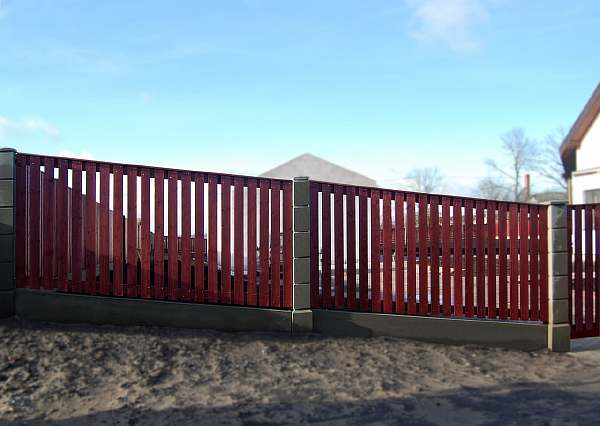 Fence with a slope in the country
Fence with a slope in the country
According to the type of relief slope, the site can be different. In this regard, the following should be noted:
- A low slope will allow you to build a fence that follows the curves of the landscape correctly. In this case, the curtain of the fence can be level. The base for the hedge is either completely absent, or a strip foundation is used.
- On a steep slope, these options for building fences look unattractive. Moreover, the need for strengthening will require a solid foundation. The hedge can be made level by installing a leveling or stepped base. That is, the individual elements are in the form of a step and have different levels.
 Wooden picket fence on uneven ground
Wooden picket fence on uneven ground
If it is not necessary to strengthen the soil on the slope and the construction of a reliable foundation is not in the construction plans, then you can build a fence from a euro-board, a board, a chain-link netting, a profiled sheet. You can build a fence with steps, installed on poles, gradually rising.
The downside of this fence is that large voids appear below in the form of a triangle. They give open access to various animals. Attackers can also get in.
So, the function of protecting the fence can be combined with the decorative one. You can get rid of voids under a wooden fence by cutting out the lower part in the form of a triangle.
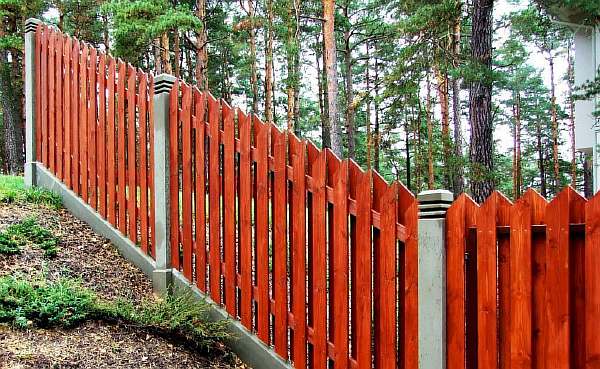 Private house fencing
Private house fencing
If you install a fence on a slope, then the choice of building material will also depend on the personal capabilities of the owner of the house:
- A fence made of wood or corrugated board is the most suitable way to build it yourself.
- A fence made of beams, a picket fence can be used for a fence that repeats the small elevation of the site.
- The most durable, but also expensive, is a concrete, brick and stone inclined fence. The construction of such fences will require a lot of preparation, experience, a significant investment of time and money.
 Metal fence with stone pillars
Metal fence with stone pillars
Strengthening the slope for the foundation
The installation of a foundation on a slope requires preliminary work to strengthen the slope. They are needed in order to avoid the heaving of the soil in winter, its shifts and other phenomena that can destroy or make the foundation less durable.
All options for strengthening slopes are based on the principle of reinforcing soil layers in order to increase their stability and strength. If the angle of inclination does not exceed 7-10%, it will be enough to plant shrubs and trees that will reduce the likelihood of landslides and keep the soil surface intact due to their branched roots.
You can create a rock garden by building ledges at the base of the slope and providing regular watering to the rocky garden.
If the angle of inclination is greater, you can install metal spacers that dig in over the entire area of the slope, use logs, stones, geonets, biomats with anchor bolts. Terracing is also well suited - the creation of retaining walls, which are characterized by ease of construction and durability. Before the construction of the retaining wall, a layer of soil is removed, drainage is made, flat stones are laid out on a hill.
When choosing a specific method of strengthening a slope for a strip, pile, slab or columnar foundation, the features of the structure itself, the orientation to the cardinal points (slope and the site as a whole), the value of the angle of inclination, the expected waterproofing layer, the composition of the soil, the depth of passage of groundwater and freezing of the earth are taken into account , specific features of the relief.
Recommendations for arranging different types of foundations on a slope with your own hands
If you have construction skills and a budget deficit for construction, then you can do the work on installing the foundation yourself. With the correct calculation and an accurate understanding of the characteristics of the soil and slope, a foundation made with your own hands will last for more than a decade.
Modern construction is carried out using new technologies and materials. Before starting the installation of the base of the house, you should read the literature and learn about them. Now, along with metal, fiberglass reinforcement is used for the foundation. It is not subject to degradation from contact with water and has a number of other advantages.
Also in the construction literature, you should read the topics about whether you need insulation for the foundation and whether it is possible to cook the reinforcement for the foundation. This information will be very useful for newbies in construction to more experienced craftsmen.
To strengthen the strength of the pile foundation, it is necessary to make a frame for the foundation from reinforcement. The piles themselves are also reinforced. You need to understand how to knit reinforcement for the foundation. In many ways, the strength of the structure depends precisely on the rigidity of the reinforcing mesh used.
Columnar structure for a residential building on a slope - you can do that!
If you need to quickly build a frame house with your own hands on a slope, then a columnar foundation structure will be most suitable. This foundation is designed for a small building mass, and most importantly, its advantage is low material costs for installation.
When erecting such foundations, it is necessary to erect a number of load-bearing pillars using one or another building material
When installing a columnar base, various materials are used: wood, brick, concrete. Wood is the most economical material and also the least time consuming. At the same time, when using wood, it is necessary to work out a waterproofing system, then the service life of the building will be more than one decade.
Brick for a columnar foundation is used most often. It is durable, reliable, but requires a lot of time and skill to install.
Reinforced concrete columnar base is reliable and strong. Its installation requires an additional formwork device. In addition, it takes time for the installation itself and the drying of the foundation before starting the main construction.
What difficulties can you face
Building on a slope can turn into some problems, especially if the height difference is significant or located near the shore of a reservoir. The main reasons may be deep ravines, the likelihood of landslides.
In such cases, the first priority is to increase the degree of structural rigidity. For this, metal structures are most often used, which are tied together with a strong strapping.

To obtain a structure that will have all the relevant characteristics, it is necessary to take into account a number of factors when performing calculations and selecting materials. For example, the greater the angle of inclination, the greater the likelihood of collapse or landslides. A fairly stable slope is a slope with a slope not exceeding 10%.
The most common problems
We will provide a list of violations that can be found in areas with a difference in elevation:
- during rains or during a thaw, the soil liquefies;
- the occurrence of landslides on the ground under its own weight;
- disturbance and slippage of the soil partially in weak places;
- the occurrence of cracks when pressure is applied to the soil of the slope.
Principles of erecting strip foundations in areas with a slope
When starting to design the foundation of a future building, it should be borne in mind that the higher the level of the difference in surface heights, the more difficult and time-consuming the necessary complex of works will be. Modern technologies for erecting a foundation on a surface with a complex relief provide several options for its construction, of which the most applicable are buried and shallow belt-type bases. Their mutual use for buildings on slopes does not create problems in the further operation of the building and ensures high reliability of the structure.

The construction site is protected from the upland side of the slope in order to prevent it from being flooded by rainwater. For this, a temporary earthen rampart is erected, or a drainage ditch is being dug, which, after pouring the foundation and making the blind area, are replaced by capital storm drains.The further volume of work performed depends on the degree of slope of the relief of the earth's surface.
Areas with a slight slope
With slight irregularities or a small height difference of no more than 10-20 cm, the site can be taken as horizontal. Excavation of soil for a foundation pit or trench should be started from the most elevated part of the site. The deepening is carried out at a single level and does not change along the entire perimeter of the foundation. In this case, it is necessary to take into account the depth of the fertile layer. If its lower boundary in some part of the area being developed exceeds the calculated depth of the foundation, then it is necessary to increase the depth of the trench at the highest point, which is calculated by the formula:
Hт - estimated depth of a trench or foundation pit;
Hпв - height difference at the construction site;
Hps - the value of the fertile soil layer.
In some cases, it is possible to do with cutting off part of the surface of a small natural slope or adding soil at the bottom of the construction site. In this case, the fertile layer is preliminarily removed and it is strengthened by careful compaction using silicates.

Plots with a medium slope
With a height difference of more than 20 cm, it would be wrong to start the development of a trench for a foundation from the highest part of the site, since in this case the base of the foundation at the lowest point may be on the surface of the ground or even higher. The most low-lying part of the site is taken as the base level, from which one should start.
Digging a trench in the lowered part is carried out to the calculated depth, taking into account the possible effect of frost heaving forces, but not less than the thickness of the fertile layer. The rest of the perimeter of the foundation cut is made at this level. In situations where the difference in heights on the site is greater than the deepening of the foundation, the size of the trench to be torn off is taken equal to the value of the difference. But in this case, the consumption of concrete when pouring the base of the building will increase significantly. In order to save money, the width of the foundation sole can be slightly reduced, but to reasonable limits.
At the end of the work, the finished foundation is backfilled with non-porous soil, which is carefully and layer-by-layer tamped. Around the structure, the soil surface is planned in the direction of a natural slope and a blind area is made.
Areas with a steep slope
Before starting work, the construction site is divided into parts for the possibility of arranging horizontal terraces at different levels, while the height of the benches should not exceed half a meter. An anti-landslide wall is constructed for each zone. Digging a trench begins from the low-lying part, after removing the vegetation layer of the soil. Further, the deepening at each level is carried out according to the design calculation.
The stepped construction of a strip foundation requires an obligatory device of high-quality drainage, since the natural movement of groundwater from the side of the upland slope after the construction of the structure will become difficult. The possible accumulation of excess moisture will have extremely negative consequences. In this regard, the drainage system is designed in advance. It is arranged around the entire perimeter of the house with a deepening to the lower level of the trench, taking into account the sand cushion.

It is advisable to carry out this option for the construction of foundations only on areas with a steep slope, since the cost of such work is extremely high. Only highly qualified specialists can be entrusted with their implementation.
Strengthening the soil around the site
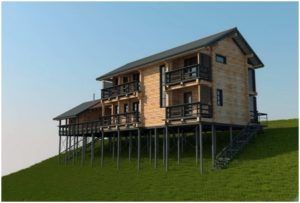 Wooden house on screw piles on a slope
Wooden house on screw piles on a slope
The slopes are subject to various destructive effects noted above in the text. To this it should be added that the descending storm flows contribute to the formation of gullies and erosion of the active layer of the soil.If you do not take care of strengthening the soil on the personal plot, then the destruction of the soil around the house can "get" to the soil base of the foundation. Therefore, it is imperative to carry out a set of measures to strengthen the slope.
With a slight slope, it is enough to plant the entire backyard area with plants that have a developed root system. The roots, deeply penetrating into the soil, create a kind of vegetative reinforcing frame of the active soil layer. The territory thus fortified will be reliably protected from negative atmospheric influences.
It is imperative to protect the site on both sides along the slope with a stepped fence foundation. Screw piles, installed with a step of 2 - 3 m, are one of the best solutions for the foundation of a fence. The gaps between the posts are filled with high curbs or reinforced concrete beams buried in the soil by at least 300 mm. The installation of the fence will block the penetration of storm water from the adjacent slope area.

